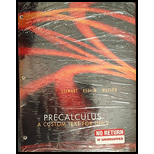
a.
The table whose perimeter is 2400 and area of each configuration is maximum.
a.
Answer to Problem 21P
The possible pairs whose perimeter is 2400 and area is maximum is length =1200 and breadth=600.
Explanation of Solution
Given information:
Concept Used:
Let x is the breadth of rectangular field and y is the length of rectangular field.
Then
y is the side parallel to river and x is the other side.
Calculation:
| X | Y | Product |
| 100 | 2200 | 210000 |
| 200 | 2000 | 40000 |
| 300 | 1800 | 540000 |
| 400 | 1600 | 640000 |
| 500 | 1400 | 700000 |
| 600 | 1200 | 720000 |
| 700 | 1000 | 700000 |
Conclusion:
Only these values are possible after that area start decreasing. So answer for maximum area 600 is breadth and 1200 is length.
b.
To determine the area in terms of one side.
b.
Answer to Problem 21P
The area is
Explanation of Solution
Given information :
Perimeter is
Concept Used:
Perimeter is
Let length of rectangular field be y and breadth be x.
Calculation:
Fencing along three sides of river.
Put equation 2 in 1,
Conclusion:
The required area in terms of one side is
c.
To compare the answer with subpart a .
c.
Answer to Problem 21P
The answer is same as subpart a .
Explanation of Solution
Given information :
Perimeter is
Concept used:
Maximise the area by using
First differentiation is equal to zero for maximization.
Calculation:
Differentiate with respect to x ,
Put
Conclusion:
The answer is same as subpart a . So model of function is correct.
Chapter 2 Solutions
Precalculus - A Custom Text for UNLV
- The spread of an infectious disease is often modeled using the following autonomous differential equation: dI - - BI(N − I) − MI, dt where I is the number of infected people, N is the total size of the population being modeled, ẞ is a constant determining the rate of transmission, and μ is the rate at which people recover from infection. Close a) (5 points) Suppose ẞ = 0.01, N = 1000, and µ = 2. Find all equilibria. b) (5 points) For the equilbria in part a), determine whether each is stable or unstable. c) (3 points) Suppose ƒ(I) = d. Draw a phase plot of f against I. (You can use Wolfram Alpha or Desmos to plot the function, or draw the dt function by hand.) Identify the equilibria as stable or unstable in the graph. d) (2 points) Explain the biological meaning of these equilibria being stable or unstable.arrow_forwardFind the indefinite integral. Check Answer: 7x 4 + 1x dxarrow_forwardshow sketcharrow_forward
- Find the indefinite integral. Check Answer: 7x 4 + 1x dxarrow_forwardQuestion 1: Evaluate the following indefinite integrals. a) (5 points) sin(2x) 1 + cos² (x) dx b) (5 points) t(2t+5)³ dt c) (5 points) √ (In(v²)+1) 4 -dv ขarrow_forwardFind the indefinite integral. Check Answer: In(5x) dx xarrow_forward
- Find the indefinite integral. Check Answer: 7x 4 + 1x dxarrow_forwardHere is a region R in Quadrant I. y 2.0 T 1.5 1.0 0.5 0.0 + 55 0.0 0.5 1.0 1.5 2.0 X It is bounded by y = x¹/3, y = 1, and x = 0. We want to evaluate this double integral. ONLY ONE order of integration will work. Good luck! The dA =???arrow_forward43–46. Directions of change Consider the following functions f and points P. Sketch the xy-plane showing P and the level curve through P. Indicate (as in Figure 15.52) the directions of maximum increase, maximum decrease, and no change for f. ■ 45. f(x, y) = x² + xy + y² + 7; P(−3, 3)arrow_forward
 Calculus: Early TranscendentalsCalculusISBN:9781285741550Author:James StewartPublisher:Cengage Learning
Calculus: Early TranscendentalsCalculusISBN:9781285741550Author:James StewartPublisher:Cengage Learning Thomas' Calculus (14th Edition)CalculusISBN:9780134438986Author:Joel R. Hass, Christopher E. Heil, Maurice D. WeirPublisher:PEARSON
Thomas' Calculus (14th Edition)CalculusISBN:9780134438986Author:Joel R. Hass, Christopher E. Heil, Maurice D. WeirPublisher:PEARSON Calculus: Early Transcendentals (3rd Edition)CalculusISBN:9780134763644Author:William L. Briggs, Lyle Cochran, Bernard Gillett, Eric SchulzPublisher:PEARSON
Calculus: Early Transcendentals (3rd Edition)CalculusISBN:9780134763644Author:William L. Briggs, Lyle Cochran, Bernard Gillett, Eric SchulzPublisher:PEARSON Calculus: Early TranscendentalsCalculusISBN:9781319050740Author:Jon Rogawski, Colin Adams, Robert FranzosaPublisher:W. H. Freeman
Calculus: Early TranscendentalsCalculusISBN:9781319050740Author:Jon Rogawski, Colin Adams, Robert FranzosaPublisher:W. H. Freeman
 Calculus: Early Transcendental FunctionsCalculusISBN:9781337552516Author:Ron Larson, Bruce H. EdwardsPublisher:Cengage Learning
Calculus: Early Transcendental FunctionsCalculusISBN:9781337552516Author:Ron Larson, Bruce H. EdwardsPublisher:Cengage Learning





